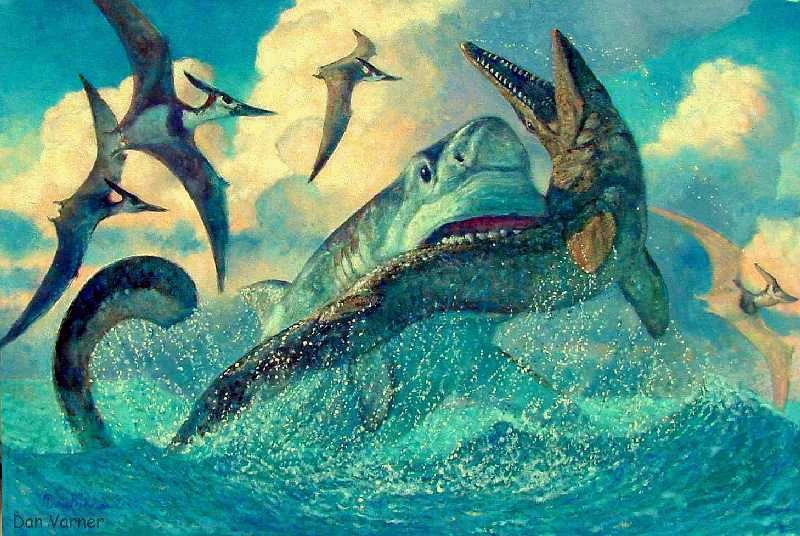During the Late Cretaceous period, North America was intersected by a vast ocean. Dubbed the Western Interior Seaway, this shallow sea – which stretched from the Arctic Circle to the Gulf of Mexico – was host to a massive assortment of aquatic life. Amongst the giant mosasaurs and long-necked Elasmosaurids were a much more familiar group of marine organisms: the sharks.
Many sharks called the Western Interior Seaway home, though none were as impressive as Cretoxyrhina mantelli. At 6-7 meters long, Cretoxyrhina was longer than the Great White Shark and just as ferocious. Nicknamed the “Ginsu Shark” based on their ability to slash through prey like the kitchen knife, Cretoxyrhina was an apex predator of its time, eating just about any animal brave enough to cross its path.

One such animal was the infamous pterosaur Pteranodon. With a wingspan between 4-7 meters and an instantly recognizable head crest, Pteranodon has become a very archetypal pterosaur to the public. Multiple Pteranodon specimens have been found with fish bones in their gut cavities, which suggests they were piscivores[i]. Though these dynamic aerial predators were able to exploit the surplus of prey available in the Western Interior Seaway, their trips out to sea put them into contact with the slicing bite of the Ginsu Shark…
Enter LACM 50926, a specimen of Pteranodon with evidence of a Ginsu Shark attack. On display at the Los Angeles County Museum of Natural History, LACM 50926 contains a shark tooth embedded within the cervical (neck) vertebrae. A 2018 study identified the tooth as belonging to Cretoxyrhina, signifying that the Ginsu Shark was responsible for the mutilated Pteranodon[ii]. Never mind slicing and dicing; Cretoxyrhina punctured the bones of Pteranodon!

LACM 50926, with a close-up of the cervical vertebrae indicating the location of the Cretoxyrhina tooth. ©Hone et al.
Although LACM 50926 was estimated to be double the length of its predator[iii], it still would have been easy prey for Cretoxyrhina. Pterosaur bones are light and hollow, meaning they would have been easy work for the blade-like teeth of the Ginsu Shark. It’s possible that Cretoxyrhina propelled itself from the water like modern Great Whites to pluck a Pteranodon out of the air!

Unfortunately, paleontologists cannot decipher whether Cretoxyrhina was actively hunting or scavenging the Pteranodon. A single embedded tooth gives little information about the nature of the attack, meaning this information could be lost forever. It doesn’t help that LACM 50926 is a composite fossil, meaning that the specimen comprises numerous Pteranodon individuals. The rest of the skeleton likely represents a different individual from the vertebrae, thus providing no additional information about the individual which the cervical vertebrae belonged.
While this event may seem unique, Ginsu Shark attacks are shockingly common in the fossil record. The list of animals with evidence of Ginsu Shark predation is extensive and includes two dinosaur species that floated out to sea; numerous mosasaurs, including a 7-meter long hypercarnivore Tylosaurus; an Elasmosaurid paddle with slash-marks across the humerus; and, of course, our poor Pteranodon[iv].

Given the abundance of Ginsu Shark attacks, it’s clear that Cretoxyrhina was an active predator in the Cretaceous seas. In some ways, this likens them to the modern Tiger Shark, who have been found eating everything from seals to seabirds to porcupines and licence plates[v]. Whether Cretoxyrhina was hunting all these animals is unclear, though one thing it certain: it wasn’t a picky eater!
Have a merry Shark Week, everybody! While the Discovery Channel’s programming this year has been…subpar, to say the least, I hope today’s article makes up for the lack of good content. If you are interested in reading about other prehistoric sharks, I suggest you read about Helicoprion and the strangest jaws in the fossil record, here at Max’s Blogosaurus!
I do not take credit for any images found in this article. Header image courtesy of Mark Witton, whose work can be found here.
Works Cited:
[i] Witton, Mark P. “Pterosaurs in Mesozoic Food Webs: A Review of Fossil Evidence.” Geological Society, London, Special Publications, vol. 455, no. 1, 2017, pp. 7–23, https://doi.org/10.1144/sp455.3.
[ii] Hone, David W.E., et al. “Evidence for the Cretaceous Shark Cretoxyrhina Mantelli Feeding on the Pterosaur Pteranodon from the Niobrara Formation.” PeerJ, vol. 6, 2018, https://doi.org/10.7717/peerj.6031.
[iii] See above.
[iv] Everhart, Michael J. Oceans of Kansas: A Natural History of the Western Interior Sea. 2nd ed., Indiana University Press, 2017.
[v] “The 14 Weirdest Things Sharks Have Eaten – Welcome to Sharksider.Com!” Shark Sider, 19 Oct. 2022, www.sharksider.com/14-weirdest-things-sharks-eaten/.
